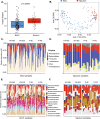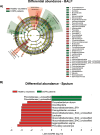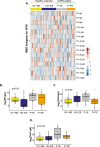NTHi killing activity is reduced in COPD patients and is associated with a differential microbiome
- PMID: 39885466
- PMCID: PMC11781068
- DOI: 10.1186/s12931-025-03113-z
NTHi killing activity is reduced in COPD patients and is associated with a differential microbiome
Abstract
Chronic obstructive pulmonary disease (COPD) is a chronic lung disease characterized by airway obstruction and inflammation. Non-typeable Haemophilus influenzae (NTHi) lung infections are common in COPD, promoting frequent exacerbations and accelerated lung function decline. The relationship with immune responses and NTHi are poorly understood. Herein, we comprehensively characterized the respiratory microbiome and mycobiome of patients while investigating microbial dynamics and host immune changes attributable to NTHi killing activity. Mild-to-moderate COPD patients encompassing frequent and infrequent exacerbators and healthy volunteers (HV) were enrolled. Microbial composition, proteomics and NTHi killing activity was analyzed using bronchoalveolar lavage fluid (BALF). In addition, antigen-antibody titers in sera to COPD pathogens were determined using a multiplex assay. Differential abundance analysis revealed an enrichment of Actinobacteria and Bacteroidetes in the BALF of COPD and HV subjects respectively. Significant differences in the IgA titer response were observed against NTHi antigens in COPD vs. HV. Notably, there was also significantly greater killing activity against NTHi in BALF from COPD vs. HV subjects (OR = 5.64; 95% CI = 1.75-20.20; p = 0.001). Stratification of COPD patients by NTHi killing activity identified unique microbial and protein signatures wherein Firmicutes, Actinobacteria and haptoglobin were enriched in patients with killing activity. We report that differences in host immune responses and NTHi-killing activity are associated with microbiome changes in mild-to-moderate COPD. This is suggestive of a potential link between the respiratory microbiome and immune activity against NTHi in the context of COPD pathogenesis even at this disease stage.
Keywords: COPD; Exacerbations; Microbiome; Non-typeable Haemophilus influenzae.
© 2025. The Author(s).
Conflict of interest statement
Declarations. Ethics approval and consent to participate: All subjects gave written informed consent. The study was approved by National Research Ethics Service South Central – Hampshire A and Oxford C Committees (LREC no: 15/SC/0528) and complied with the Declaration of Helsinki. Consent for publication: Not applicable. Competing interests: This work was funded by AstraZeneca. Vancheswaran Gopalakrishnan, Ben Sparklin, Jung Hwan Kim, Margaret Kehl, Tara Kenny, Christopher Morehouse, Carolina Caceres, Paul Warrener, Ventzislava A. Hristova, Susan Wilson, Harini Shandilya, Arnita Barnes, Alexey Ruzin, Junmin Wang, Lisa Oberg, Bastian Angermann, Christopher McCrae, Adam Platt, Daniel Muthas, Sonja Hess, Christine Tkaczyk, Bret R. Sellman, Kristoffer Ostridge, Maria G. Belvisi and Antonio DiGiandomenico are/were employees of AstraZeneca and own stocks/shares. Vancheswaran Gopalakrishnan is a co-inventor on US patent PCT/US17/53,717 and on a provisional US patent WO2020106983A1. Karl Staples has received collaborative grants from AstraZeneca for this work, from Epiendo outside of the current work, and speaker fees from AstraZeneca.
Figures




References
MeSH terms
LinkOut - more resources
Full Text Sources
Medical
Miscellaneous

